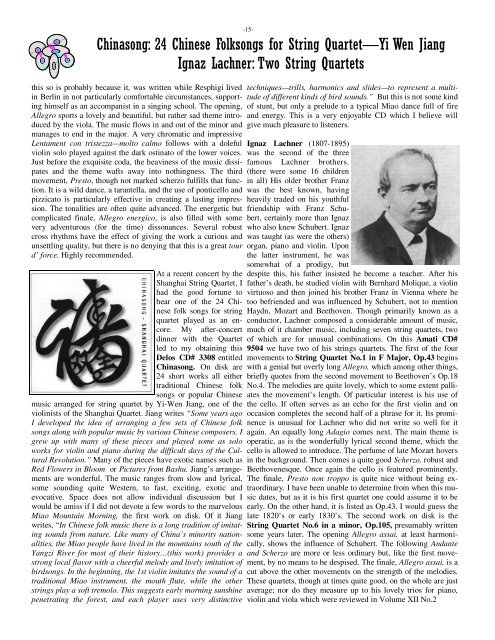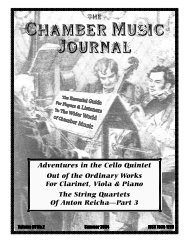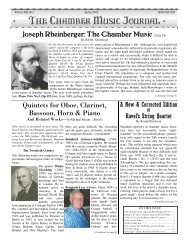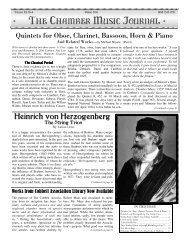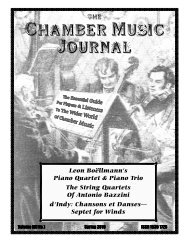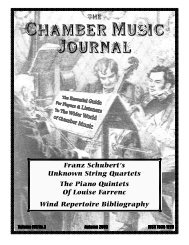Volume 14 No.4 - Cobbett Association
Volume 14 No.4 - Cobbett Association
Volume 14 No.4 - Cobbett Association
Create successful ePaper yourself
Turn your PDF publications into a flip-book with our unique Google optimized e-Paper software.
this so is probably because it, was written while Resphigi lived<br />
in Berlin in not particularly comfortable circumstances, supporting<br />
himself as an accompanist in a singing school. The opening,<br />
Allegro sports a lovely and beautiful, but rather sad theme introduced<br />
by the viola. The music flows in and out of the minor and<br />
manages to end in the major. A very chromatic and impressive<br />
Lentament con tristezza—molto calmo follows with a doleful<br />
violin solo played against the dark ostinato of the lower voices.<br />
Just before the exquisite coda, the heaviness of the music dissipates<br />
and the theme wafts away into nothingness. The third<br />
movement, Presto, though not marked scherzo fulfills that function.<br />
It is a wild dance, a tarantella, and the use of ponticello and<br />
pizzicato is particularly effective in creating a lasting impression.<br />
The tonalities are often quite advanced. The energetic but<br />
complicated finale, Allegro energico, is also filled with some<br />
very adventurous (for the time) dissonances. Several robust<br />
cross rhythms have the effect of giving the work a curious and<br />
unsettling quality, but there is no denying that this is a great tour<br />
d’ force. Highly recommended.<br />
At a recent concert by the<br />
Shanghai String Quartet, I<br />
had the good fortune to<br />
hear one of the 24 Chinese<br />
folk songs for string<br />
quartet played as an encore.<br />
My after-concert<br />
dinner with the Quartet<br />
led to my obtaining this<br />
Delos CD# 3308 entitled<br />
Chinasong. On disk are<br />
24 short works all either<br />
traditional Chinese folk<br />
songs or popular Chinese<br />
music arranged for string quartet by Yi-Wen Jiang, one of the<br />
violinists of the Shanghai Quartet. Jiang writes “Some years ago<br />
I developed the idea of arranging a few sets of Chinese folk<br />
songs along with popular music by various Chinese composers. I<br />
grew up with many of these pieces and played some as solo<br />
works for violin and piano during the difficult days of the Cultural<br />
Revolution.” Many of the pieces have exotic names such as<br />
Red Flowers in Bloom or Pictures from Bashu. Jiang’s arrangements<br />
are wonderful. The music ranges from slow and lyrical,<br />
some sounding quite Western, to fast, exciting, exotic and<br />
evocative. Space does not allow individual discussion but I<br />
would be amiss if I did not devote a few words to the marvelous<br />
Miao Mountain Morning, the first work on disk. Of it Jiang<br />
writes, “In Chinese folk music there is a long tradition of imitating<br />
sounds from nature. Like many of China’s minority nationalities,<br />
the Miao people have lived in the mountains south of the<br />
Yangzi River for most of their history…(this work) provides a<br />
strong local flavor with a cheerful melody and lively imitation of<br />
birdsongs. In the beginning, the 1st violin imitates the sound of a<br />
traditional Miao instrument, the mouth flute, while the other<br />
strings play a soft tremolo. This suggests early morning sunshine<br />
penetrating the forest, and each player uses very distinctive<br />
-15-<br />
Chinasong: 24 Chinese Folksongs for String Quartet—Yi Wen Jiang<br />
Ignaz Lachner: Two String Quartets<br />
techniques—trills, harmonics and slides—to represent a multitude<br />
of different kinds of bird sounds.” But this is not some kind<br />
of stunt, but only a prelude to a typical Miao dance full of fire<br />
and energy. This is a very enjoyable CD which I believe will<br />
give much pleasure to listeners.<br />
Ignaz Lachner (1807-1895)<br />
was the second of the three<br />
famous Lachner brothers.<br />
(there were some 16 children<br />
in all) His older brother Franz<br />
was the best known, having<br />
heavily traded on his youthful<br />
friendship with Franz Schubert,<br />
certainly more than Ignaz<br />
who also knew Schubert. Ignaz<br />
was taught (as were the others)<br />
organ, piano and violin. Upon<br />
the latter instrument, he was<br />
somewhat of a prodigy, but<br />
despite this, his father insisted he become a teacher. After his<br />
father’s death, he studied violin with Bernhard Molique, a violin<br />
virtuoso and then joined his brother Franz in Vienna where he<br />
too befriended and was influenced by Schubert, not to mention<br />
Haydn, Mozart and Beethoven. Though primarily known as a<br />
conductor, Lachner composed a considerable amount of music,<br />
much of it chamber music, including seven string quartets, two<br />
of which are for unusual combinations. On this Amati CD#<br />
9504 we have two of his strings quartets. The first of the four<br />
movements to String Quartet No.1 in F Major, Op.43 begins<br />
with a genial but overly long Allegro, which among other things,<br />
briefly quotes from the second movement to Beethoven’s Op.18<br />
<strong>No.4</strong>. The melodies are quite lovely, which to some extent palliates<br />
the movement’s length. Of particular interest is his use of<br />
the cello. If often serves as an echo for the first violin and on<br />
occasion completes the second half of a phrase for it. Its prominence<br />
is unusual for Lachner who did not write so well for it<br />
again. An equally long Adagio comes next. The main theme is<br />
operatic, as is the wonderfully lyrical second theme, which the<br />
cello is allowed to introduce. The perfume of late Mozart hovers<br />
in the background. Then comes a quite good Scherzo, robust and<br />
Beethovenesque. Once again the cello is featured prominently.<br />
The finale, Presto non troppo is quite nice without being extraordinary.<br />
I have been unable to determine from when this music<br />
dates, but as it is his first quartet one could assume it to be<br />
early. On the other hand, it is listed as Op.43. I would guess the<br />
late 1820’s or early 1830’s. The second work on disk is the<br />
String Quartet No.6 in a minor, Op.105, presumably written<br />
some years later. The opening Allegro assai, at least harmonically,<br />
shows the influence of Schubert. The following Andante<br />
and Scherzo are more or less ordinary but, like the first movement,<br />
by no means to be despised. The finale, Allegro assai, is a<br />
cut above the other movements on the strength of the melodies.<br />
These quartets, though at times quite good, on the whole are just<br />
average; nor do they measure up to his lovely trios for piano,<br />
violin and viola which were reviewed in <strong>Volume</strong> XII No.2


